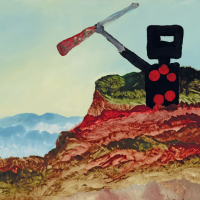16. SIDNEY NOLAN

The first of these Kelly pictures was painted between 1945 and 1947 The scale is large, and the execution nave: a primitive treatment that seemed, at the time, to be a somewhat systematic and artful way of achieving an atmosphere of folklore in these pictures. Mr Nolan has told me that his use of this method was quite deliberate, for the reason that there are practically no folk forms that one can borrow in Australia (other than the aboriginal): and that Kellys own words, and Rousseau, and sunlight are the ingredients of which they were made.1
The words of Colin MacInnes sound through time, acknowledging the extraordinary series of Kelly paintings that Sidney Nolan painted at Heide in 1946-47. The unassailable importance and resonance of the series is well noted and to that we can add the continued evolution of the Kelly series undertaken by Nolan in the mid-1950s, the 1980s, and beyond.
Whether primitive was a euphemism for the series or indeed we would think of aboriginal art as folkloric, MacInnes identified something apparent in Australian art. No fire had been lit in Australian modern art to cast the very shadow that spoke to Australians and their identity. Nolan had this at heart when painting the Kelly suite, but in 1955 he exhibited a further version of the Kelly series in London. Despite similar themes, the paintings and those that were of Kelly were more refined and attuned to modernism. Nolan had made good the promise of the first series, but he had adapted Kelly and was to take him further, onto a greater stage.
Kelly and Rifle 1980 is one of a series of Kelly paintings from the 1980s. There were nine from the series, which apart from our present lot were exhibited at Rudy Komon Gallery in Sydney in 1981: Kelly and Bridge 1980, Kelly and Reflection 1980, Kelly and Road 1980, Kelly and Mirage 1980, Kelly and River 1980, Kelly and Township 1980, Kelly and Horse 1980, and Kelly and Landscape 1980
Kelly and Moonlight 1980 was also included in the exhibition and illustrates the telling fact of its making. The series was painted in synthetic polymer paint, a medium that Nolan relished. It allowed him great facility, no less a new range of colours, and fast drying times. Kelly and Moonlight is a wonderful image redolent with poetic appeal. The view is compelling with a sense of movement innate to the composition. Most importantly, the ghost of expectation hangs above Kelly, and on his shoulder the tawny green, the green of the landscape, shows as a patch of moonlight.
By taking a step back in date to Ned Kelly 1973, does not diminish formal or imagistic terms. Kelly looms as a spectre in the dry outback. The painting shares similarities with our present lot, no less the placement of Kelly, who appears large and singular. Kelly is a watcher in Ned Kelly 1973. He appears by surprise and seems to observe rather than threaten. Nolans landscape is sparse but the trees to the middle ground and at the foot of the mountain leaven the eye and the anxiety of the composition. The feeling of this painting is seen in Kenneth Clarks suggestion that Nolans paintings have a faint colour of menace.2
The change in formal orientation and in representation of the Kelly figure was noted by Bryan Robertson, who along with Kenneth Clark was a great champion of Australian painters in the 1950s and 60s.
To a certain extent, most of the Nolans work is both recapitulatory and organic in the sense that several strands of idea and visual concept in various groups of paintings are progressively gathered together and combined in fresh juxtapositions.3
This describes most accurately Nolans revisiting of different series over time and with new purpose, by refashioning imagery and enlarging iconography. Although a difficult proposition, Nolan maintained a great desire to reinterpret themes. Speed of hand and speed of thought were Nolans great attributes, and we find this in perfect accord in Kelly and Rifle.
There is a privilege in bringing a painting of this stature to market. There is fluidity to the image of Kelly and Rifle that is built upon invention. The wibbled paint of the foreground gives way to the rocky knoll from which Kelly emerges, rifle in hand. It is over thirty years since the Heide Kellys, but time is negligible. Nolans great pictorial nous and reinvention are what has us in thrall to Kelly and Rifle. The liquid shape of the helmet surmounts the breast plate. Shots have been fired but defiantly, Kelly is steadfast and still here, his longevity intact.
Footnotes:
1. Colin MacInnes, in Clark, K., MacInnes, C. & Robertson, B., Sidney Nolan, Thames & Hudson, London, 1961, p.30
2. Kenneth Clark, in Clark, K., MacInnes, C. & Robertson, B., op. cit., p.10
3. Bryan Robertson, in Clark, K., MacInnes, C. & Robertson, B., op. cit., p.46
Brett Ballard